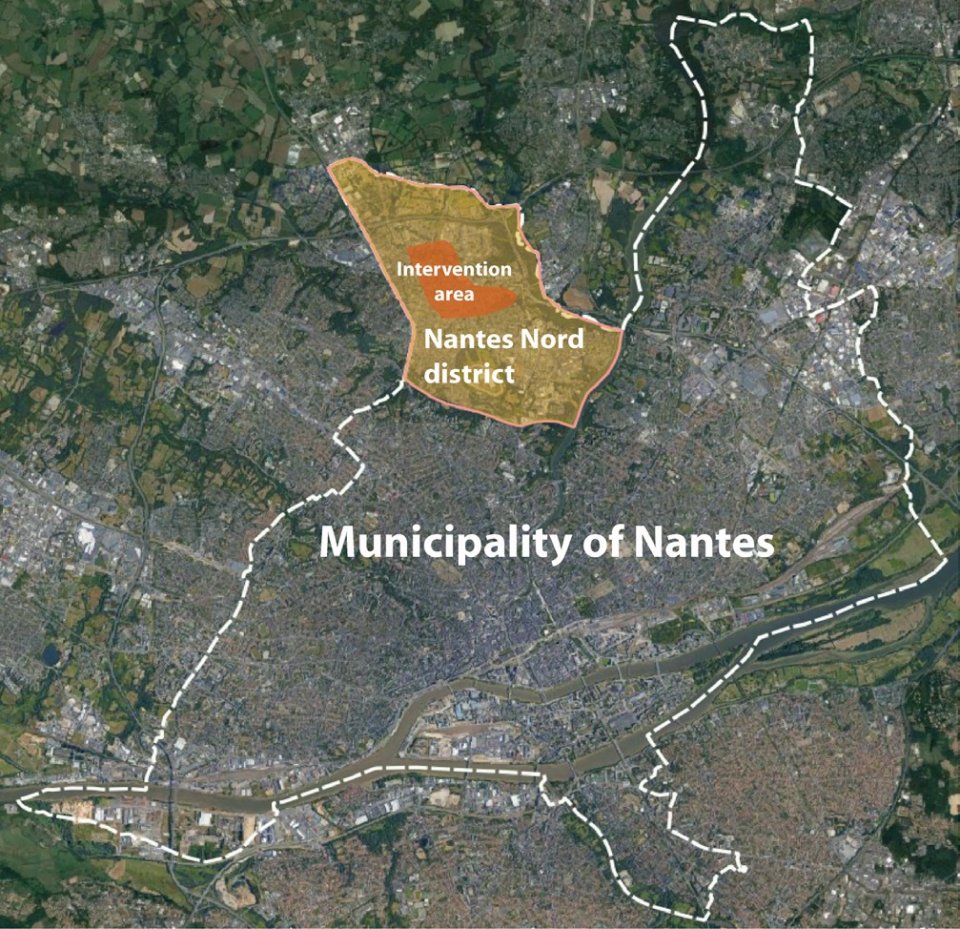
Nantes Nord perimeter is the study area.
This corresponds both to the diagnostic and evaluation scale. The intervention area focuses on a reduced area in the North of Nantes Nord, where are the priority districts (QPV), the social housing districts with concentration of difficulties. Located in the north-western part of the city, the “Nantes Nord” district is one of the 11 districts of Nantes municipality. It is itself subdivided in 9 micro-districts.
The municipality saw an opportunity in URBiNAT as a preliminary to the Global Project. The two projects indeed share the same general objectives of improving the health and the well-being of the inhabitants. URBiNAT also meets the municipality concerns of the co-creation process: the so-called Citizen Dialogue, that the municipality has enforced as a way of doing since 2014. The integration in URBiNAT also allows going further in the co-creation process already existing in Nantes, with especially the co-evaluation phase. The municipality has therefore chosen to integrate Nantes Nord as a study area for the URBiNAT project.
Another argument is that the city of Nantes wants to share its experience and explore more in depth the appropriateness of giving more space to green spaces and nature (and by extension to open and public spaces) in urban renovation. The city of Nantes, through its local history (horticultural and botanical activities) and through a strong political support for several years (“Four flowers” national award in 1988, European Green Capital in 2013), gives importance to the place of vegetation (nature and gardens) in the city. Urban landscape is thus a strategy for the urban development of the city. At the metropolitan level, this strategy is taking shape in the “Green Star “scheme. Seen from the sky, Nantes, with its network of rivers and parks, looks like a large, graphic green and blue star. Announced in 2015 and inspired by Boston’s “Emerald Necklace”, the plan highlights the networking of the green corridors that run along the Loire, Erdre, Cens, Gesvres, Chézine and Sèvre rivers with Nantes’ major parks and green spaces that create a network of biodiversity and walking paths. The municipality has already several experiences of this urban landscape approach in eco-districts, or in projects in central spaces of the city, but it is a challenge to extend it in a social housing renovation one.
Within URBiNAT intervention area, four preliminary framework units were identified.
- “The Canada park”, a multifunctional urban park with attention on social cohesion and gender issue on public space;
- “The re-opening of the Renards stream”, with a focus on biodiversity;
- “The green loop”, the first walking path out of 5 planned for the district, as a tool for physical activity and support for immaterial NbS;
- Healthy food production access to all though green spaces and community gardens at the district scale. (The initial idea was to take over the Angle Chaillou farm by the municipality, but the negotiations were not successful and the thematic of urban agriculture was rethought through other channels).
Based on local diagnostics, they were determined both on location, specific thematic, concerned inhabitants and the local stakeholders involved.
The URBiNAT urban project integrates the design of a multifunctional urban park, the creation of a walking loop support of most of the immaterial NbS and a new tool of animation for the local stakeholders, especially in line with the construction of the Health Centre, and the preparatory studies and activities of the reopening and renaturation of the Renards stream.
This aims to answer the different objectives identified through the co-creation process:
- Provide to inhabitants’ access to affordable fruits and vegetables
- Develop active mobility for travels within the neighbourhood
- Favor children physical activity (including girls)
- Green and public spaces contribute to wellbeing (favour contact with nature, social relations)
- Provide new outdoor community spaces in public spaces
- Propose community activities and opportunities for social interactions
- Improve access and visibility to existing parks and public spaces Valuing biodiversity among the inhabitants
- Use outdoor space as educative support
- Create and improve by several equipment places to stay and to meet
- Improve accessibility and continuities of public spaces on material and immaterial levels
- Development of an economy that benefits to the inhabitants (including jobs)
- Developing climate change adaptation; improving risk management and resilience
- Increase infiltration / Water storage
- Developing climate change mitigation
- More energy efficient buildings
- Reduction of energy in the production of new buildings and building materials
- Greater ecological connectivity across urban regenerated sites
- Improve connectivity and functionality of green and blue infrastructures
- Increase quality and quantity of green and blue infrastructures
- Increased cultural richness and biodiversity
- Enhancing sustainable urbanisation
- Changing image of the urban environment
- Increase accessibility to green open spaces
- Increase amount of green open spaces for residents
- Increase awareness of NBS solution & their effectiveness and co benefits
- Increase communities’ sense of ownership
- Increase well-being
- Increase willingness to invest in NBS
- Social inclusion
Paper abstract: Urban gardening is now booming. Local authorities are taking part in this dynamic to meet the demand of inhabitants but also because they see it as a solution to many of the challenges of the sustainable city. As a result, they are faced with the issue of soil quality. Urban soils are a rarely highlighted environmental compartment and are subject to numerous constraints: loss of agronomic potential or pollution. Based on experiences in Nantes, the article explores the process by which cities establish a diagnosis and then intervene on soil quality, addressing both the tools and the interactions with the inhabitants-gardeners. The landscape approach adopted makes it possible to jointly address, and if necessary link, the many challenges of soil apprehension by local authorities, both in terms of the unknowns that persist on urban soils, the skills and finally the difficulty of articulating the technical and political dimensions.
Beatrice Béchet (IRSTV)
Alain Yvrenogeau (NM)
Philippe Bodénan (IRSTV, Nantes Métropole)
- 3. Good Health and Well-being
- 11. Sustainable Cities and Communities
- 12. Responsible Consumption and Production
- 13. Climate Action

